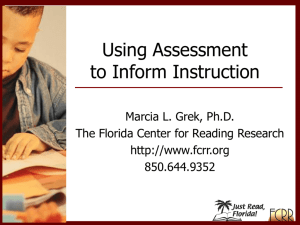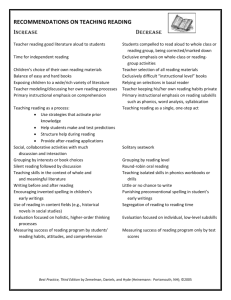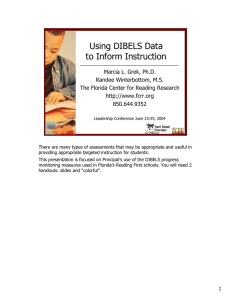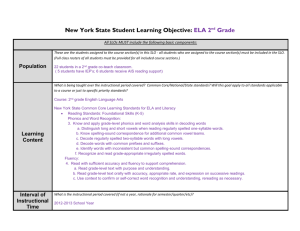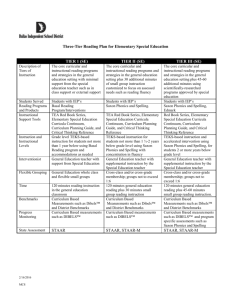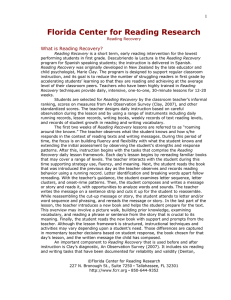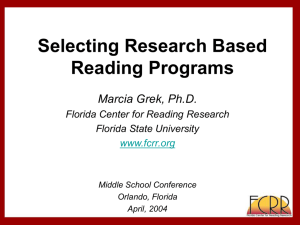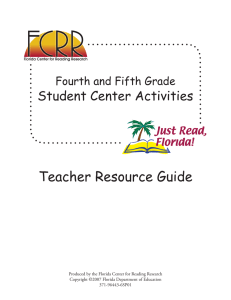Downloadable PowerPoint - Florida Center for Reading Research
advertisement
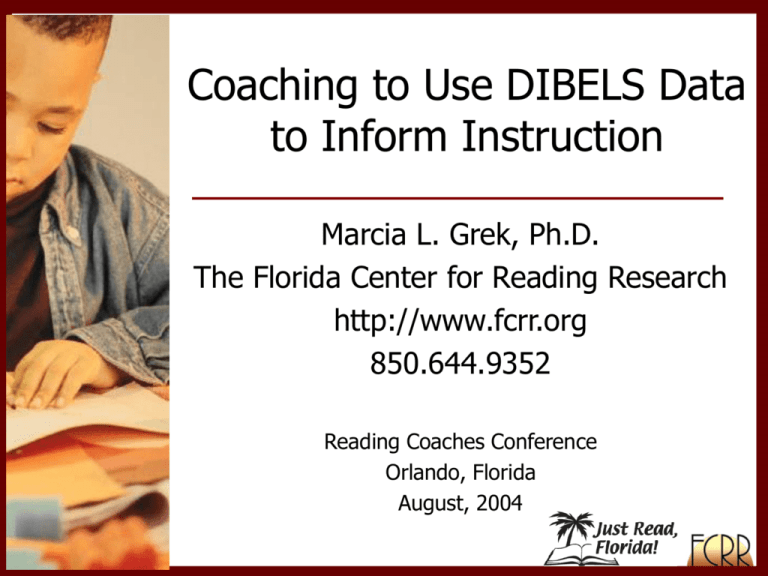
Coaching to Use DIBELS Data to Inform Instruction Marcia L. Grek, Ph.D. The Florida Center for Reading Research http://www.fcrr.org 850.644.9352 Reading Coaches Conference Orlando, Florida August, 2004 Background Knowledge • Reading First in Florida – – – – – • Responsibilities of school level personnel Model for student success Florida’s formula to leave no child behind DIBELS measures Progress Monitoring and Reporting Network (PMRN) Two important resources – http://www.fcrr.org/assessment/index.htm – http://www.fcrr.org/pmrn/ Responsibilities of the Principal • • • To evaluate effectiveness of building level strategies for organization and management To identify where extra resources and support are needed in specific grade levels and classrooms To evaluate the effectiveness of new or continued curriculum (including supplementary/interventions and instructional strategies) Teacher Responsibilities • Uninterrupted 90 minute (minimum) block of reading instruction • Implement high quality initial instruction • Implement differentiated instruction • Implement immediate intensive intervention Responsibilities of the Coach From Florida’s Reading First Grant: • …Coaches can assist principals in developing grade level instructional teams at each school to monitor individual and classroom level progress in reading and to make data based decisions about instruction… Reading Coaches need in-depth knowledge about • Data Analysis • Individual Problem Solving • Classroom Organization Model for Student Success Continuous Assessment Instruction Data-Based Instructiona l Planning 5 + 3 + ii + iii = NCLB 5 Five skills on which early reading instruction should focus 3 Three types of assessment to guide instruction Screening Progress monitoring Diagnosis ii High quality initial instruction is critical iii Immediate intensive interventions for children lagging behind in the growth of critical reading skills GRADE Kindergarten DIBELS MEASURE Initial Sounds, Phoneme Segmentation Letter Naming, Nonsense Words First Third Phonemic Awareness Phonics Phoneme Segmentation Phonemic Awareness Letter Naming, Nonsense Words Phonics Oral Reading Second READING COMPONENT ASSESSED Reading Fluency Nonsense Words Phonics Oral Reading Reading Fluency Oral Reading Reading Fluency What is the PMRN? (Progress Monitoring and Reporting Network) A Web-based data management system that provides: - a convenient place for entering and organizing the results of student assessments, - a secure, centralized, easily accessible location for the storage of student information, - a tool for timely and helpful reports so that educators can effectively analyze data, plan instruction, and communicate student progress. Objectives for Today Participants will: • understand how to use the following reports generated by the Progress Monitoring and Reporting Network (PMRN) to make instructional decisions – – – – – School Status Report School Grade Summary Report School Progress Report Class Status Report Class Progress Tracking Report Risk Level Key PMRN Sign In Page 1 Page 1 Page 2 Page 3 Median Page 3 Page 4 Class Status Report The Class Status Reports from the Progress Monitoring & Reporting Network (PMRN) will help answer three important questions: 1. Who needs extra support? 2. How should groups be formed? 3. Which skills need to be emphasized? Class Status Report page 5 • Kindergarten Class • Assessment Period 4 1. Complete the activity on page 6 of your colorful handout by using the report found on page 5. Work individually or with a partner. Who Needs Extra Support? High Risk: 7 Moderate Risk: 3 Low Risk: 9 page 5 How will small groups be formed? • Group 1: Students 1, 3, 5, 7, 8 • Group 2: Students 2, 4, 6, 9, 10 (12, possibly) • Group 3: Students 11-19 page 5 Which skills need to be emphasized? • Group 1: PA & Phonics • Group 2: PA & Phonics • Group 3: Phonics & Fluency page 5 Classroom Organization for this Kindergarten Class • Uninterrupted 90 minute block • No other personnel to assist during Learning Center time • Scott Foresman with Links to Reading First for ii Classroom Organization for this Kindergarten Class: Teacher Led-Center • 40 minutes will be devoted to whole class ii using Scott Foresman core curriculum • 50 minutes will be devoted to small group instruction: M T W TH F 25 25 25 25 25 G2MR 15 10 15 10 15 G3LR 10 15 10 15 10 G1HR minutes Classroom Organization for this Kindergarten Class: Teacher-Led Center Small group instruction for 50 minutes: – Group 1: Implement SF ERI --25 min. daily – Group 2: Implement SF Links to RF (phonemic awareness and phonics activities will provide students extra practice with the content that was taught during ii)--10-15 min. daily – Group 3: Use the decodable books from SF to practice the decoding process and fluency--10-15 min. daily Reading First Classroom Organization: Learning Centers • Teacher-Led Center - Small group instruction • Student Centers - Academically engaged - Accountability - Group, Pair, Cooperative, Individual Flexible Groups at the Teacher-Led Center • Keep high risk group sizes small (5-7 as a maximum). • For students not making adequate progress in a group of 5-7, it is critical to reduce the group size to 3-5. • Monitor high risk student progress more frequently in order to make instructional changes, small group changes, and to accelerate learning. • It is important to work with each small group differently based on instructional need. • Consider attitudes, behaviors, and work ethics when forming and modifying groups. With a partner analyze the Progress Report and answer the questions on page 7 of your handout. Page 7 1. When should have more intensive instruction been implemented for: Student 3? After Assessment 3 Student 8? After Assessment 1 Student 16? After Assessment 1 Page 7 2. What do you notice about Student 3? • The student has not progressed in Oral Reading Fluency, but the target has increased. So, by Assessment 4, he was at high risk. Ongoing Progress Monitoring (OPM) at this point may be an option to collect more data. Page 7 3. After Assessment 3, which students should the teacher have targeted for extra instruction in Oral Reading Fluency? • Students 3, 4, 8, 10, 14, and 16 Page 7 Summary of Recommended Uses of Student Data Use Progress Reports to: – Monitor progress – Determine which students need more intensive instruction – To form flexible reading groups – Offer instructional strategies to the teacher – Determine types of professional development from which specific teachers could benefit – To write and monitor Academic Improvement Plans (AIPs) Summary of Recommended Uses of Student Data – To conduct parent conferences Important Considerations • Is the core reading program implemented with fidelity? • Is there a need for more professional development for a particular area of reading? • Is there a need for more intensive coaching? • Are materials allocated to maximize learning? • Is personnel use maximized to focus on reading instruction? • Is the instructional day scheduled such that reading is THE priority? Questions? Please use the blue question/comment cards found on your table. For additional information, please contact: Marcia L. Grek, Ph.D. Florida Center for Reading Research 227 North Bronough Street, Suite 7250 Tallahassee, FL 32301 (850) 644-9352 (V) (850) 644-9085 (F) mgrek@fcrr.org http://www.fcrr.org/reports.htm
